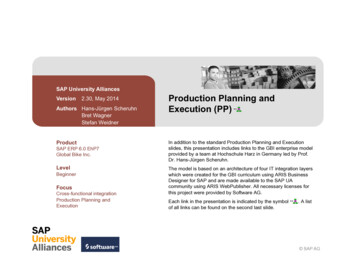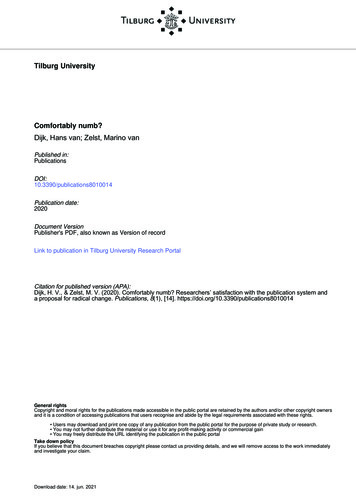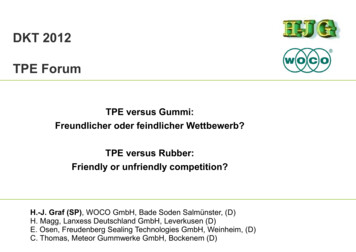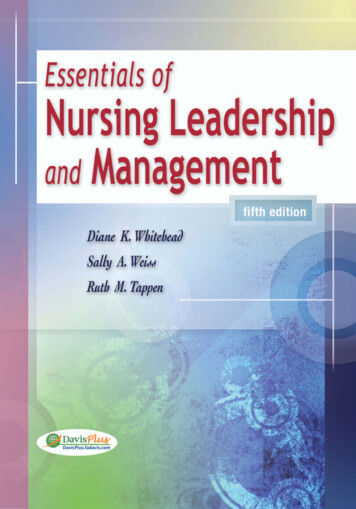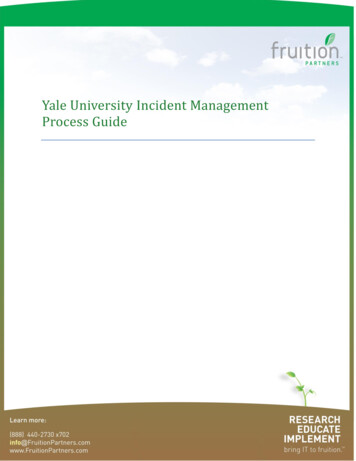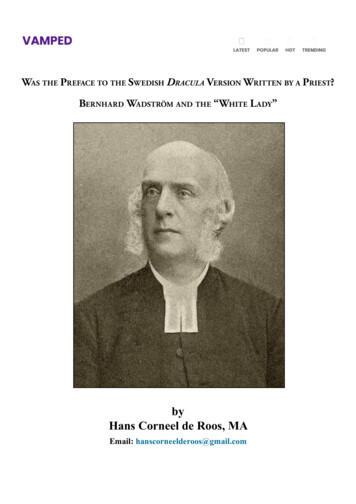
Transcription
Was the Preface to the Swedish Dracula Version Written by a Priest?Bernhard Wadström and the “White L ady ”byHans Corneel de Roos, MAEmail: hanscorneelderoos@gmail.com
Dedicated to Richie, Jane and Jiven, who sharedthe excitement of this strange discovery with me.Note: References to the Swedish text of the Dagen variant ofMörkrets makter are given in [square brackets], indicating thepage numbers as given in the newspaper serialization. For thesection describing Harker’s adventures in Transylvania (up to themiddle of page 196), the Dagen and the Aftonbladets Halfveckoupplaga variants have the same text and identical page numbers;in fact, these serializations must have been printed from thesame matrices. The Tip-Top republication of 1916-1918 wastypeset in a different format, without continuous page numbers.Note: The Icelandic text of Makt myrkranna and the Swedishtext of the variants of Mörkrets makter are in the public domain;my translations of these texts and my comments are protected byinternational copyright laws.Hans Corneel de Roos 26 May 2018 Vamped.org World Dracula Day Special Was the Preface to the Swedish Dracula Version Written by a Priest? Bernhard Wadström and the “White Lady” Page 2
Was the Preface to the Swedish Dracula Version Written by a Priest?Bernhard Wadström and the “White L ady ”by Hans Corneel de Roos, MAFor 52 months now, the question whether Bram Stoker personally contributed to the modified plot and the changedstyle of Makt myrkranna, the Icelandic version of Dracula, has haunted me. A surprising discovery I made at thestart of May 2018 now throws a new light on the matter and dramatically narrows down the options. A report.1. I ntroductionOver the past decades, the preface to the Icelandic edition has held a special place in Dracula research. It wasintroduced to the international community of Dracula aficionados by Richard Dalby, who in 1986 included anEnglish translation of this foreword by Joel H. Emerson in his Bram Stoker Omnibus.1 In 1993, he republishedthis translation in The Bram Stoker Journal, together with a reproduction of the Icelandic preface text and hiscomments on the novel, which he believed to be a “heavily abridged” translation of the 1897 British edition.2The Dalby translation of the preface became accepted as one of the few canonical texts shedding light on Stoker’sintentions and the suspected backgrounds of his novel: it suggested “the infamous murders by Jack the Ripper”originated from the same source as the events depicted in Makt myrkranna; it even seemed to state that theWhitechapel crimes themselves would appear in the Icelandic text “a little later.” As I demonstrated in 2014, thelatter part of this interpretation was the result of a defective translation from the Icelandic.3 Emerson’s error, inturn, may partly have been due to a lack of context: although Dalby had acquired a copy of the rare book andfurther copies were available for consultation at university libraries in Iceland, Denmark, England and the USA,as well as at various Icelandic public libraries, no scholar outside of Iceland ever made an effort to study the text.In January 2014, after obtaining the book’s preface from Reykjavik, I got hold of the complete text of Makt myrkranna.I soon found out that the story had been serialized in the Reykjavik newspaper Fjallkonan from 13 January 1900on, and that the Icelandic version was not – as hitherto believed – an abridged translation of Stoker’s text at all:although much shorter than Dracula, it contained many new characters and a heavily modified plot. Moreover, thestyle seemed atypical of Stoker to me: the tiresome deliberations on legal issues and the sentimental assertions offriendship between the members of Van Helsing’s team had been cut out; instead, a series of gorgeous and at timeshalf-denuded young women made their appearance. Already in my first essay on Makt myrkranna, I addressed thequestion if and to what extent Stoker had authorized the Icelandic version or even had contributed to it himself.4Over the years, even after my annotated translation of Makt myrkranna had been published by Overlook Press,New York, in February 2017, I continued to pursue this issue. My discussions with a round of Icelandic translationexperts had produced strong linguistic clues suggesting that the preface had been translated from another language,instead of being originally composed in Icelandic.5 A hint by the Swedish fantasy fiction expert Rickard Berghorngave my quest a new turn: shortly after the book release, Berghorn informed me that the Icelandic text in fact musthave been a translation of Mörkrets makter, a Swedish Dracula adaptation that had been serialized in the newspaperDagen and the magazine Aftonbladets Halfvecko-upplaga, starting in June and August 1899 respectively. But whileBerghorn insisted that the Swedish version was much longer than Stoker’s original and – unlike Makt myrkranna– upheld its epistolary style throughout the novel,6 the facsimile I received directly from the Swedish National1 Richard Dalby, A Bram Stoker Omnibus (London: Foulsham, 1986).2 Richard Dalby, “Makt Myrkranna – Power of Darkness,” Bram Stoker Journal 5 (1993): 2-8. In the second part of Dalby’s article,the plural Powers of Darkness was used for the Icelandic novel; as such it became listed in various Dracula-related bibliographies.3 See my article “Makt Myrkranna – Mother of all Dracula Modifications?,” Letter from Castle Dracula, 4 February 2014: 3-19, and myintroduction to Powers of Darkness (New York: Overlook Press, 2017), 13-43.4 See my article “Makt Myrkranna – Mother of all Dracula Modifications?”: 12ff.5 In January-February 2016, I discussed this issue per email with Ásgeir Jónsson (the editor of the third Icelandic edition) and a seriesof translation experts from Icelandic universities and language research institutes.6 See my interview with Rickard Berghorn, Children of the Night Congress Bulletin, 5 March 2017: 8.Hans Corneel de Roos 26 May 2018 Vamped.org World Dracula Day Special Was the Preface to the Swedish Dracula Version Written by a Priest? Bernhard Wadström and the “White Lady” Page 3
Library on 8 March 2017 showed otherwise: although longer than the Icelandic version, this text was definitelyshorter than Dracula and after Harker’s adventures in Transylvania switched to a conventional chapter style.I concluded that the shorter variant I had got hold of – as published in Aftonbladets Halfvecko-upplaga – must havebeen the text translated by Ásmundsson, while Berghorn had gained access to an extended variant – as publishedin Dagen and later reprinted in the magazine Tip-Top.7The status of these variants, however, remained unclear; the questions and doubts I had already worded regardingStoker’s possible role in creating Makt myrkranna now had to be transposed to Mörkrets makter. Like before, wecould not be certain that (1) the hint in the preface pointing to the Thames Torso Murders, (2) the mentioning ofVan Helsing as a real person and (3) the Hamlet quote actually came from Stoker; the parallels between Stoker’searly notes for Dracula and similar elements showing up in the northern adaptations might result from an exchangeof ideas between Stoker and his Swedish translator/editor, or even from an early draft of Dracula that the Irishmanhad sent to Sweden – or, alternatively, they might be due to pure coincidence, as argued by Jason Colavita.8Early April 2017, I updated my annotation and my introduction to Powers of Darkness to reflect my newest insightsand inform readers about Swedish plot clues that had been omitted from Makt myrkranna; although OverlookPress agreed to include this update in a second print run, a concrete time schedule for this has not materialized yet.Meanwhile, I wrote a series of research essays about the hidden identity of the Swedish translator/editor of Mörkretsmakter: both Swedish variants in their title state that these adaptations had been wrought by “A-e.” Based on anumber of clues I found in the Swedish press of that time, I presented the journalist Anders Albert AnderssonEdenberg (1834-1913) as a possible and plausible candidate.9Research on Makt myrkranna has stalled for almost three decades after Dalby first published its preface, becauseno scholar outside Iceland thought of the possibility that its plot might deviate from that of Dracula, and no one inIceland thought it useful to inform an international audience – just like the Swedish literary experts familiar withMörkrets makter never felt the urge to publish about it abroad until my Powers of Darkness caused a global buzz.10It is curious to see that today, 14 months after the news about the Swedish version broke,11 no other scholar yethas delved into the similarities and differences between the Icelandic and Swedish text variants available now.In October 2017, Berghorn republished the text of the Tip-Top version.12 Apart from that, facsimiles of both theDagen, the Halfvecko-upplaga and the Tip-Top publications have been available from the Swedish National Library.At least the Swedish preface should have attracted some scrutiny: first, in order to determine if and to what extentthe Icelandic preface matched its Swedish counterpart, and, second, to determine if the Swedish text, too, pointedto a translation – as should be expected in case Bram Stoker had authored it himself. The question whether Stokerwithin a few years after the publication of his magnus opus consented – or even actively contributed – to a radicalre-interpretation of his vampire novel should be of eminent interest to all Dracula scholars and fans; still, the millsof university-based research into Victorian and/or Gothic Literature – fields almost all major academic institutionshave appointed special professors and lecturers for – seem to turn too slow to catch up with recent developments.Now that I, for the time being, have rounded up my research about the hidden identities of Professor van Helsing13and the anonymous translator/editor of Mörkrets makter, I decided to take a closer look at the Swedish preface myself.147 I established this in my emails to Rickard Berghorn of 11 March 2017.8 Jason Colavita, “Why the Icelandic ‘Dracula’ Adaptation Is Probably Not Evidence for a Lost Original Version of Bram Stoker’sClassic Vampire Novel,” online blog of 15 February 2017.9 See my article “Was Anders Albert Andersson-Edenberg the First Author to Modify Dracula?,” Vamped.org of 27 March 2018, foran overview of these findings and for references to my earlier publications on this issue.10 My article “On Dracula’s Lost Icelandic Sister Text. How a Supposed Translation proved to be much more” for The Literary Hub of6 February 2017 was clicked 30,000 times in the first weeks.11 See the special Children of the Night Congress Bulletin of 5 March 2017, and “Icelandic version of Dracula, Makt myrkranna, turns outto be Swedish in origin,” Iceland Monitor, 6 March 2017, an article I set up together with the journalist Anna Margrét Björnsson.12 Rickard Berghorn (ed.), Mörkrets makter (Landsbro: Aleph Bokförlag, 2017).13 See my article “Dracula’s Best-Kept Secret – The Hidden Identity of Professor Abraham van Helsing,” also in Vamped.org of 26 May 2018.14 A little caveat: I never studied Swedish in any structured way. But as I found out, this language is much closer to Dutch (my mothertongue), German (which I speak and write fluently since I moved to Munich in 1986) and Icelandic (which I had to tackle fortranslating Makt myrkranna) than to English (which remains a hopelessly illogical language). It is very well possible, though, thatsome translation errors have slipped through; I trust that my Swedish colleagues will be more than happy to point them out to me.Hans Corneel de Roos 26 May 2018 Vamped.org World Dracula Day Special Was the Preface to the Swedish Dracula Version Written by a Priest? Bernhard Wadström and the “White Lady” Page 4
2. S ource Te xtsa ndTr a nsl ationsPreface to Mörkrets makter as appearing in Aftonbladets Halfvecko-upplaga of 16 August 1899First part of the preface in Dagen of 10 June 1899First part of the preface in Tip-Top, 1916, nr. 40, p. 13Hans Corneel de Roos 26 May 2018 Vamped.org World Dracula Day Special Was the Preface to the Swedish Dracula Version Written by a Priest? Bernhard Wadström and the “White Lady” Page 5
Preface to Makt myrkranna (fragment), as published in Fjallkonan, 13 January 1900, p. 4Hans Corneel de Roos 26 May 2018 Vamped.org World Dracula Day Special Was the Preface to the Swedish Dracula Version Written by a Priest? Bernhard Wadström and the “White Lady” Page 6
Mörkrets makterRoman af Bram StokerSvensk Bearbetning för Dagen af A–eFörord af utgifvaren1Huru dessa papper blifvit samlade samt ordnade till ett sammanhängande helt torde bli läsaren klartunder berättelsens gång. Min uppgift har endast varit att så vidt som möjligt utesluta öfverflödiga detaljer,samt för öfrigt låta de handlande personerna sjelfva meddela sina erfarenheter i den okonstlade form varide från början blifvit upptecknade. Jag har äfven af lätt förklarliga skäl tillåtit mig ändra åtskilliga såvälorts- som personnamn, men för ötrigt öfverlämnar jag, enligt de personers önskan, som därmed ansett siguppfylla en bjudande plikt, det hela oförändrat och i sitt ursprungliga skick åt offentligheten.Det finns enligt min öfvertygelse inte en skymt af tvifvel att de här skildrade tilldragelserna verkligenegt rum, hur osannolika och oförklarliga de än måste förefalla, sedda ur den hvardagliga erfarenhetenssynpunkt. Oförklarliga måste de, enligt min öfvertygelse, dock delvis alltid förblifva – ehuru det ujingalunda är otänkbart att fortskridande forskningar på det dolda 2 själslifvets och naturkrafternas områdeförr än man väntat skulle kunna kasta ett bjärt ljus öfver såväl denna som många andra hemligheter,hvilka hittills envist trotsat både vetenskapsmannens och detektivens av erfarenhet skärpta blick. Jagupprepar emellertid än en gång, att hela den hemlighetsfulla tragedi, som här skildras till sina yttre dragär fullkomligt sann, äfven om mitt eget omdöme i vissa fall kommit till andra slutsatser och förklaringarän de hvilka synts de handlande personerna sjelfva antagliga. Men fakta är obestridliga samt därtill ihufvudsak kända af alltför många för att kunna betviflas. Den serie af – som det tycktes3 – fullkomligtoförklarliga brott, alla tydande på samma ursprung, hvilka på sin tid upprörde allmänheten lika mycketsom de något senare så beryktade Whitechapelmorden, torde ännu inte vara fullkomligt glömda; en ochannan torde äfven påminna sig de båda intressanta främlingar, hvilka under ett par säsonger speladeen glänsande roll inom societeten och av hvilka åtminstone den ena helt plötsligt och på ett hittillsoförklarat sätt försvann, utan att lämna något spår efter sig. Alla de personer, hvilkas redogörelser förden roll de – med eller mot sin vilja – spelat i denna underliga historia, här blifvit sammanförda, är välkända och allmänt aktade. Såväl Thomas Harker som hans älskvärda hustru och dr Seward är sedanmånga år tillbaka mina personliga vänner, på hvilkas sanningsenlighet jag vet mig obetingat kunna lita;och den vördnadsvärde vetenskapsman, som här uppträder under ett fingerat namn, torde i sjelfva verketvara alltför känd och uppburen inom hela den civiliserade verlden för att hans verkliga namn – hvilketjag dock ej velat utsätta – skulle kunna förblifva en hemlighet för de många, hvilka af erfarenhet lärtuppskatta och vörda såväl hans snille som hans ädla och människoälskande sinnelag, äfven om de – ilikhet med mig sjelf – ej alltid kan dela hans världsåskådning och de slutsatser, hvartill en liflig fantasioch en naturlig benägenhet för mystik i vissa fall fört honom. Emellertid torde det i våra dagar mer ännågonsin vara klart för allvarligt tänkande människor, att det verkligen »gifves mycket mellan himmeloch jord, hvarom vår filosofi ej kunnat drömma». Mer än någonsin gäller det nu att med fördomsfrittsinne pröfva allt, som kommer inom kretsen för ens iakttagelser, med liflig hågkomst af de många storavetenskapliga upptäckter och den vidgade kännedom om naturens lagar, hvartill första väckelsen gifvits aviakttagelser, hvilka av en trångsynt och alltför materialistisk samtid endast mötts med hån och förföljelse.För den verklige forskaren är lättrogenhet och vidskepelse lika – men inte mer – förkastliga än den torraskepticismens eviga hångrin gent öfver allt obekant och tillsvidare oförklarligt. Det är därför som jag utantvekan i enlighet med mina vänners önskan åt offentligheten öfverlämnar följande anteckningar, hvilkasintresse – ur hvilken synpunkt man föredrar att bedöma dem – ingen torde kunna förneka.London, –– Street, aug. 1898.B.S.1 Text as first published in Dagen of 10 June 1899 and Aftonbladets Halfvecko-upplaga of 16 August 1899. In the Tip-Top republication of 1916-18, republished by Aleph Books in October 2017, “af” has been changed to “av,” “hvilka” to “vilka,” etc.2 Swedish “dold” means “hidden,” “obscured” or “invisible”. In the definite form “dolda,” the term can relate to “område”(“field”) or to “själslifvets” (lit.: “of the life of the soul”), but it can also include “naturkrafternas” (“of the forces of nature”).3 In the Tip-Top republication, “tycktes” (seemed) has been replaced by “tycks” (seems). In this context, the past tense seemsmore appropriate to me, as Mörkrets makter is offering an explanation for this series of crimes now – at least in part.Hans Corneel de Roos 26 May 2018 Vamped.org World Dracula Day Special Was the Preface to the Swedish Dracula Version Written by a Priest? Bernhard Wadström and the “White Lady” Page 7
M akt MyrkrannaRóman Eftir Bram Stoker.Formáli höfundarins1Lesarinn getur sjálfur séð, þegar hann les sögu þessa, hvernig þessum blöðum hefur verið raðaðsaman, svo að þau yrðu að einni heild. Ég hef ekki þurft að gera annað en að draga úr þeim ýms2 óþörfsmáatvik og láta svo sögufólkið sjálft skýra frá reynslu sinni í þeim sama einfalda búningi, sem blöðinupphaflega eru skrifuð í. Ég hef, af augljósum ástæðum, breytt nöfnum manna og staða. En að öðru leytiskila ég handritinu óbreyttu, samkvæmt ósk þeirra, sem hafa álitið það stranga skyldu sína, að koma þvífyrir almenningssjónir.Eftir minni sannfæringu er það ekkert efamál, að þeir viðburðir, sem hér er lýst, hafi sannarlega áttsér stað,3 hversu ótrúlegir og óskiljanlegir sem þeir kunna að sýnast, skoðaðir eftir almennri reynslu. Ogég er sannfærður um, að þeir hljóta jafnan að verða að nokkru leyti óskiljanlegir, þótt ekki sé óhugsandi,að áframhaldandi rannsóknir í sálfræðinni og náttúrufræðinni geti, þegar minnst varir, skýrt bæði þessaog aðra leyndardóma, sem hvorki vísindamenn né njósnarlögreglan hafa enn þá getað skilið. Ég tek þaðenn á ný fram, að þessi dularfulli sorgarleikur, sem hér er lýst, er fullkomlega sannur, að því er alla ytriviðburði snertir, þótt ég eðlilega hafi komist að annarri niðurstöðu í ýmsum greinum en sögufólkið. Enviðburðirnir4 eru ómótmælanlegir, og svo margir þekkja þá, að þeim5 verður ekki neitað. Þessi röð afglæpum er mönnum ekki úr minni liðin, röð af glæpum, sem virðast6 óskiljanlegir en út leit fyrir, að væruaf sömu rót runnir, og slógu á sínum tíma jafnmiklum óhug á almenning sem hin alræmdu morð Jakobskviðristara, sem komu litlu seinna til sögunnar. Ýmsa mun reka minni til hinna merkilegu útlendinga,sem misserum saman tóku glæsilegan þátt í lífi tignarfólksins hér í Lundúnum, og menn muna eftir því,að annar þeirra7 að minnsta kosti hvarf skyndilega og á óskiljanlegan hátt, án þess að nokkur merki hanssæist8 framar. Allt það fólk, sem sagt er að viljandi eða óviljandi hafi tekið þátt í þessari merkilegu sögu, eralþekkt og vel metið. Bæði Tómas Harker og konan hans, sem er valkvendi, og dr. Seward eru vinir mínirog hafa verið í mörg ár, og ég hef aldrei efað, að þau segðu satt frá; og hinn mikilsmetni vísindamaður,sem kemur hér fram með dularnafni, mun líka vera of frægur um allan hinn menntaða heim, til þess aðmönnum dyljist hið rétta nafn hans, sem ég hef ekki viljað nefna, síst þeim, sem af reynslu hafa lært aðmeta og virða snilld hans og mannkosti, þótt þeir ekki fremur en ég fylgi lífsskoðunum hans.En á vorum dögum ætti það að vera ljóst öllum alvarlega hugsandi mönnum,„harðla margt er á himni og jórðu,sem heimspekina dreymir ei um.“Lundúnum, — stræti, águst 1898.B.S.1 Text as first published in Fjallkonan of 13 January 1900, 4. For an English translation and comments on errors andomissions in the translation by Joel H. Emerson, see my book Powers of Darkness (New York: Overlook Press, 2017), 61-63.2 Read: ýmis.3 The italics only appear in the Fjallkonan serialization, not in the book edition of August 1901 and later republications.4 Instead of the indefinite form (fakta facts) as used in Swedish, the Icelandic text uses the definite form here (the facts).5 Here and in other cases, Valdimar uses the dative, here in combination with “verður neitað” (auxiliary verb, cf. German“werden,” plus supine form of “ad neita” to deny). As I checked in the Icelandic press archive, the use of the dative insuch cases was not unusual in Valdimar’s time. Discussed per email with Ragna Eyjolfsdóttir in January 2016.6 Valdimar opted for “virðast” here, the present tense instead of the past tense. See fn. 3 on the previous page.7 As noted by Ásgeir Jónsson in his email 1 February 2014, the Icelandic “annar þeirra” refers to the other of a pair, not to oneof a group, as indicated in Emerson’s translation. Ásgeir’s precise observation is confirmed by the text of the Swedish preface.8 The form “sæist” is the subjunctive past tense, third person singular of the mediopassive form of the strong verb “sjá”: “sothat no signs of him was ever seen again.” One would expect the third person plural form “sæjust” here, as given in thesecond edition of 1950 and the third edition of 2011. Valdimar, however, also used the singular verb form in Fjallkonanof 20 April 1892, 63 (“hvort nokkur merki væri ugglaus ”). The final meaning stays the same.Hans Corneel de Roos 26 May 2018 Vamped.org World Dracula Day Special Was the Preface to the Swedish Dracula Version Written by a Priest? Bernhard Wadström and the “White Lady” Page 8
Powers of DarknessNovel by Bram StokerSwedish A daptation for Dagen by A–eEditor’s Preface1How these papers have been collected and arranged to form a coherent whole will become clear to thereader in the course of the story. My task has merely been to eliminate unnecessary details as far as possible,and for the rest allow the actors themselves to report their experiences in the same plain form in which theywere initially taken down. I have also, for easily explainable reasons, allowed myself to change some names ofplaces and persons, but for the rest, in accordance with the wish of the people who believe to fulfil an imperativepersonal duty this way,2 I hereby pass everything unchanged and in its original condition to the public.There is, in my conviction, not a shade of doubt that the events pictured here really took place, nomatter how unlikely and inexplicable they may appear, seen from the perspective of everyday experience.Inexplicable, however, they must in part remain, I believe ‒ though it is by no means unthinkable thatongoing research in the field of natural and hidden psychical forces,3 before we may expect it, will cast abright light on both these and many other secrets, that so far have stubbornly defied both the scientist’s andthe detective’s acumen, sharpened by experience. I repeat once again, however, that the entire mysterioustragedy described here in its outer features is completely true, even though in some instances, my ownjudgment has come to other conclusions and explanations than those that seem plausible to the actingpersons. But facts are indisputable, and moreover, in the main points they are known by too many peopleto be open to doubt. This series of – as it seemed – completely unexplainable crimes, all pointing to thesame origin, that in their time troubled the public as much as the so infamous Whitechapel murdershappening somewhat later, should not be completely forgotten yet; some people may also remember thetwo interesting strangers who, for a couple of seasons, played a glamorous role in the high society4 andof whom at least one all of a sudden and in a hitherto unexplained way disappeared, without leaving anytrace behind. All persons, whose reports about the role they – willingly or unwillingly – played in thisstrange story have been collected here, are well-known and widely respected. For many years, both ThomasHarker and his charming wife and Dr. Seward have been my personal friends, on whose truthfulness,I know, I can rely unconditionally; and the revered scientist, who appears here under a pseudonym, in factmay be all too famous and celebrated throughout the civilized world, for his real name – which I do notwish to disclose here all the same – to remain a secret to the many who from experience have learned toappreciate and honor both his genius and his noble and philanthropic mind, though they – like myself– can not always share his world view and the conclusions to which a lively imagination and a naturaltendency to mysticism in some cases have led him. However, today, more than ever, it might be clearto seriously thinking people that there really “are more things in heaven and earth, than are dreamt ofin our philosophy.”5 More than ever, it is now a matter of examining, without prejudice, all that comeswithin the circle of our perception, with a lively recollection of the many great scientific discoveries andour broadened knowledge of the laws of nature, that has initially grown on the basis of 6 observations thatfrom the side of narrow-minded and all too materialistic contemporaries were only met with mockery andpersecution. For the true scientist, credulity and superstition are just as – but no more – objectionable as7the eternal sardonic grin of dry skepticism toward everything unknown and hitherto unexplained. Thatis why I, without doubt in accordance with the wish of my friends,8 present the following notes, whosesignificance – from whatever viewpoint one might prefer to judge them – no one could deny.London, –– Street, Aug. 1898.B.S.1 The Swedish term “utgi(f)varen” literally means “publisher.” As this preface is signed with Stoker’s initials, this must refer to Stoker’sassumed role as the editor (German: “Herausgeber”) of a text written by others, not to “A-e” or the publisher of the newspaper.2 Swedish: “sig uppfylla en ( ) plikt.” English and German have no matching reflexive phrase, hence my translation “personal.”3 See p. 7, fn. 2. As I suspect that “dolda” refers to hidden psychical forces or mechanisms, I have opted for this solution.4 Swedish: “societeten,” lit.: “society,” here in the sense of “high society,” “elite,” “higher circles,” etc.5 In Hamlet: “There are more things in heaven and earth, Horatio, than are dreamt of in (y)our philosophy.”6 Swedish: “( ) vartill första väckelsen givits av, ( )” lit.: “( ) to which the first revival was given by ( )”7 Correct but less elegant: “( ) just as objectionable as, but no more objectionable than ( ).”8 The Swedish “utan tvekan i enlighet” uses no commas, hence this somewhat awkward translation: from the first paragraph,we already know that the editor’s friends expressly wish these materials to be published.Hans Corneel de Roos 26 May 2018 Vamped.org World Dracula Day Special Was the Preface to the Swedish Dracula Version Written by a Priest? Bernhard Wadström and the “White Lady” Page 9
M ächte der FinsternisRomanBram StokerSwedische Überarbeitung für Dagen: A–eVorwort des Herausgebers1Wie diese Papiere gesammelt und geordnet wurden um ein zusammenhängendes Ganzes zu bilden sollteim Laufe der Erzählung deutlich werden. Meine Aufgabe bestand lediglich darin, unnötige Details wo möglichzu streichen und es den Akteuren selbst zu ermöglichen, ihre Erfahrungen in derselben ungekünstelten Formzu veröffentlichen, in der sie ursprünglich zu Papier gebracht wurden. Aus leicht verständlichen Gründen habeich mir auch erlaubt, manche Orts- und Personennamen zu ändern, aber im Übrigen übergebe ich, gemäßdem Wünsch der Personen, die hiermit eine gebietende persönliche Pflicht zu erfüllen glauben, das gesamteMaterial unverändert und in seiner ursprünglichen Fassung der Öffentlichkeit.Es gibt meines Erachtens keinen Schimmer von Zweifel daran, dass die hier geschilderten Ereignissewirklich stattfanden, wie unwahrscheinlich und unerklärlich sie im Lichte der alltäglichen Erfahrung aucherscheinen müssen. Unerklärlich müssen sie, nach meiner Überzeugung, jedoch teilweise immer bleiben –obwohl es keineswegs ausgeschlossen ist, dass der Fortschritt der Forschung im Bereich des verborgenenSeelenleebens und der Kräfte der Natur früher als erwartet ein klares Licht auf diese sowie auf viele andereGeheimnisse werfen könnte, die bisher hartnäckig dem durch Erfahrung geschulten Blick des Wissenschaftlerssowie des Detektivs getrotzt haben. Ich wiederhole aber noch einmal, dass die ganze mysteriöse Tragödie, wiehier dargestellt, in ihren äußeren Merkmalen absolut wahr ist, auch wenn mein eigenes Urteil manchmal zuanderen Schlüssen und Erklärungen gekommen ist als die, welche den handlenden Personen selbst plausibelerscheinen. Aber Tatsachen sind unbestreitbar, und außerdem sind sie in den wesentlichen Punkten zu vielenMenschen bekannt um fraglich zu sein. Diese Serie von – wie es schien – völlig unerklärlichen Verbrechen,die alle auf den gleichen Ursprung hinwiesen und in ihrer Zeit die Öffentlichkeit ebensosehr beunruhigtewie die später so berüchtigten Whitechapel-Morde, dürfte noch nicht vollständig vergessen sein; mancheLeute dürften sich auch an die beiden interessanten Ausländer erinner
Classic Vampire Novel,” online blog of 15 February 2017. 9 See my article “Was Anders Albert Andersson-Edenberg the First Author to Modify Dracula?,” Vamped.org of 27 March 2018, for an overview of these findings and for references to my earlier publications on this
